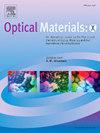Modulation of spectroscopic properties in the YXO4 compounds (where X = V5+, P5+, As5+) doped with Eu3+ ions
Q2 Engineering
引用次数: 0
Abstract
In the present work, a co-precipitation method was employed to prepare nanosized YXO4 (X = V5+, P5+, As5+) doped with Eu3+ ions. The raw nanomaterials have been thermally treated in temperature range between 300 and 1100 °C for 3h. The XRD analysis demonstrated that the powders were single-phase with high crystallite dispersion. The studies focused on investigating the systematic relationship between crystallographic parameters and spectroscopic properties. The average size of the obtained materials was 30 nm for YVO4, 35 nm for YPO4, and 20 nm for YAsO4, respectively.
Moreover, the emission and excitation spectra, although typical for Eu3+ ions, demonstrated some degree of variability with calcination temperatures and doping concentration. Thermal luminescence quenching was typical for YPO4 and YAsO4 samples, while for the YVO4 samples, the intensity of emission increased, reaching its maximum at 725 K. To explain this phenomenon, excitation spectra in function of temperature were measured.
掺杂 Eu3+ 离子的 YXO4 化合物(其中 X = V5+、P5+、As5+)的光谱特性变化
本研究采用共沉淀法制备了掺杂 Eu3+ 离子的纳米级 YXO4(X = V5+、P5+、As5+)。原始纳米材料在 300 至 1100 °C 的温度范围内经过 3 小时的热处理。XRD 分析表明,这些粉末是单相的,具有较高的晶体分散性。研究的重点是调查晶体学参数与光谱特性之间的系统关系。所得材料的平均粒度分别为:YVO4 30 nm、YPO4 35 nm 和 YAsO4 20 nm。此外,发射光谱和激发光谱虽然是 Eu3+ 离子的典型光谱,但随着煅烧温度和掺杂浓度的不同而呈现出一定程度的变化。对于 YPO4 和 YAsO4 样品来说,热淬灭是典型的发光现象,而对于 YVO4 样品来说,发射强度增加,在 725 K 时达到最大值。
本文章由计算机程序翻译,如有差异,请以英文原文为准。
求助全文
约1分钟内获得全文
求助全文
来源期刊

Optical Materials: X
Engineering-Electrical and Electronic Engineering
CiteScore
3.30
自引率
0.00%
发文量
73
审稿时长
91 days
 求助内容:
求助内容: 应助结果提醒方式:
应助结果提醒方式:


